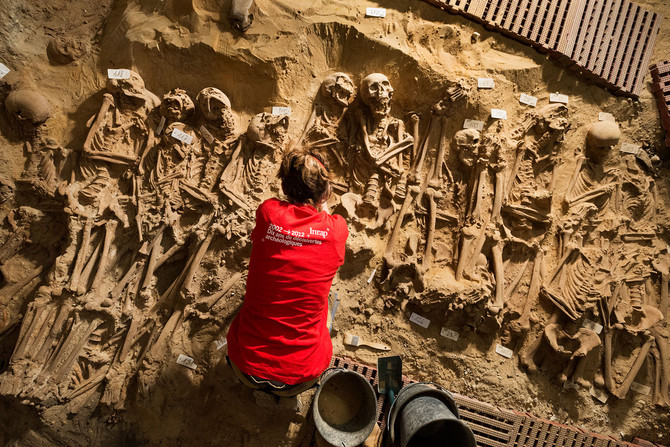
More than 200 bodies were recently unearthed in several mass burials beneath a Paris supermarket.
The bodies, which were lined up head to feet, were found at the site of an ancient cemetery attached to the Trinity Hospital, which was founded in the 13th century.
Though it's not clear exactly how these ancient people died, the trove of bodies could reveal insights into how people in the Middle Ages buried their dead during epidemics or famine, the researchers involved said.
Supermarket renovations
The burials were discovered during renovations to the basement of the Monoprix Réaumur-Sébastopol supermarket, located in the second-arrondissement neighborhood of Paris. As workers lowered the floor level of the basement, they found a shocking surprise: the bodies of men, women and children, neatly arranged in what looked to be mass graves. [See Images of the Ancient Hospital Burials]
The site was once the location of the Trinity Hospital, which was founded in 1202 by two German noblemen. The hospital was conceived not just as a place to provide care for the sick, but also as one where weary pilgrims and travelers could rest and enjoy themselves, according to a 1983 presentation given at the French Society on the History of Medicine.
But in 1353, during the height of the Black Death, the hospital also opened a cemetery, which provided a lucrative side business for the religious folk who operated the hospital, according to the presentation. During that catastrophic period, hundreds of people a day died in the Hôtel-Dieu de Paris, the city's oldest hospital, and burial space was tough to find in the crowded city. Occasionally, the overflow bodies were buried at the Trinity Hospital site, according to the presentation.
Sign up for the Live Science daily newsletter now
Get the world’s most fascinating discoveries delivered straight to your inbox.
Mass death
So far, archaeologists have uncovered about eight mass burial pits on different levels of the site. Seven of those sites hold between five and 20 individuals, while the remaining pit contains more than 150 bodies, according to a statement about the findings.
The bodies were laid down methodically in neat rows, head to feet, with one burial extending beyond the boundaries of the excavation. The pits contain the skeletons of men and women, old and young, none of which show obvious signs of injury or disease.
Given the huge number of skeletons found, it seems likely the bodies were buried during some mass medical crisis, when too many people were dying at once to provide individual burials, the researchers note in the statement.
As a follow-up, the team plans to use radioactive isotopes of carbon (elements of carbon with different numbers of neutrons) to estimate when these people lived. By combining this data with ancient texts and maps of Medieval Paris, researchers hope to reveal how and when these people died.
In the 1500s, the Trinity Hospital converted to a site where little boys and girls trained as apprentices. By the 1700s, the site fell into disrepair. During the French Revolution, the hospital was destroyed and the remaining structures were turned into stables for animals, according to the presentation.
Follow Tia Ghose on Twitterand Google+. Follow Live Science @livescience, Facebook & Google+. Originally published on Live Science.

Tia is the managing editor and was previously a senior writer for Live Science. Her work has appeared in Scientific American, Wired.com and other outlets. She holds a master's degree in bioengineering from the University of Washington, a graduate certificate in science writing from UC Santa Cruz and a bachelor's degree in mechanical engineering from the University of Texas at Austin. Tia was part of a team at the Milwaukee Journal Sentinel that published the Empty Cradles series on preterm births, which won multiple awards, including the 2012 Casey Medal for Meritorious Journalism.










